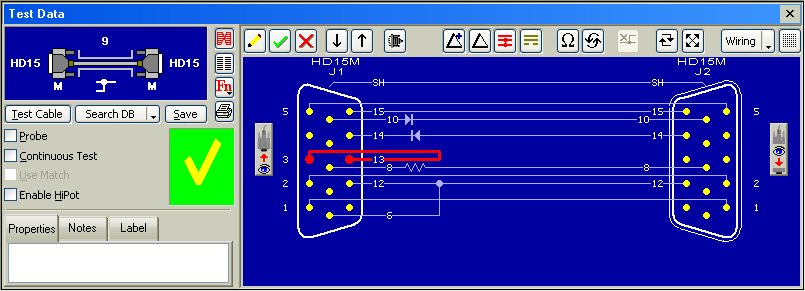If you suspect a wiring error in a cable or just do not know how the pins are connected, you may show the cable's schematic on your monitor for review. CableEye's software draws this wiring diagram automatically. Highlight a connection of interest, as shown in red below, to clarify wire paths in complex cables. You are looking at an exact screen shot from a color monitor, not a drawing (control buttons described below). Click to see a wire harness graphic (multiple connectors, more complex wiring).
|
|
FLIP VIEW - The small buttons with the red arrows near each connector show the direction of view into the connector. In this case, we are looking into the pins of the left connector and the terminations of the right connector. You may click these buttons to change the view as desired. |
|
|
VIEW CABLE WIRING - This is the view you see here with the wiring schematic and blue screen. |
|
|
VIEW NETLIST - Show the connection data in a grid as a From-To list or Pin list. |
|
|
EDIT CABLE DATA - Make editing changes to the displayed wiring. Note: the data can be edited only by operators who have been assigned sufficient privilege level. |
|
|
SAVE EDITING CHANGES - Commit changes made. You must then click the "Save" button to save these changes to the database. |
|
|
CANCEL EDITING CHANGES - Restore the data as it existed prior to editing. |
|
|
SCROLL WIRE UP or DOWN - Scroll down or up to highlight a wire of interest. |
|
|
ADD NEW CONNECTOR - When in the Editing mode, add a new connector to the drawing. Once added, you may then also add wiring, resistors, or diodes if desired. You may also change an existing connector type if desired rather than adding a new one. |
|
|
OVERLAY WIRING DIFFERENCES - Compare the Test Data (shown in this drawing) with Match Data (the ideal cable, not shown here) and highlight the wiring differences between them. |
|
|
VIEW WIRING DIFFERENCES - Graphically highlight only the differences between Test Data and Match Data. |
|
|
MEASURE RESISTANCE OF HIGHLIGHTED WIRE - First, select a wire by clicking on it with the mouse, or scrolling to it, and then click this button to measure its resistance (M3U or higher testers only). |
|
|
MEASURE RESISTANCE CONTINUOUSLY - Same as measuring the resistance of a highlighted wire, above, but this continuously repeats. Use this function to hunt for intermittent connections or bad solder joints. |
|
|
SWAP TEST and MATCH DATA - Momentarily swap Test Data with Match Data so that you can see subtle differences in the wiring. |
|
|
EXPAND TO FULL SCREEN VIEW - Expand the Test Data to fill the entire available screen to see complex wiring. |
Add descriptive notes and text to this schematic and store it in an online database for future reference. You may create a filename up to 19 characters long using any alphanumeric characters available on the keyboard. CableEye includes its own internal database manager especially designed for storing cable information. However, you may export cable data (wire list, file name, and notes) in comma-delimited ASCII format for use by external database, spreadsheet, or word processor programs.
